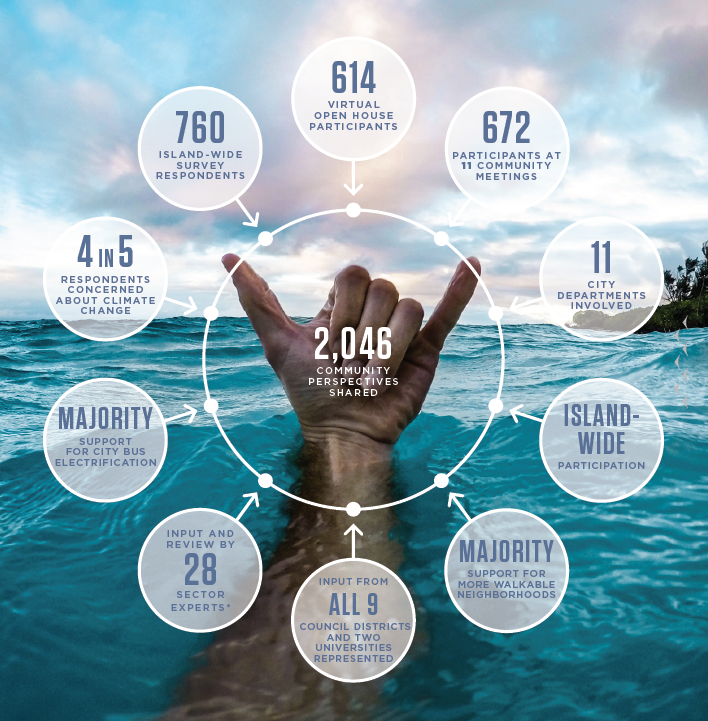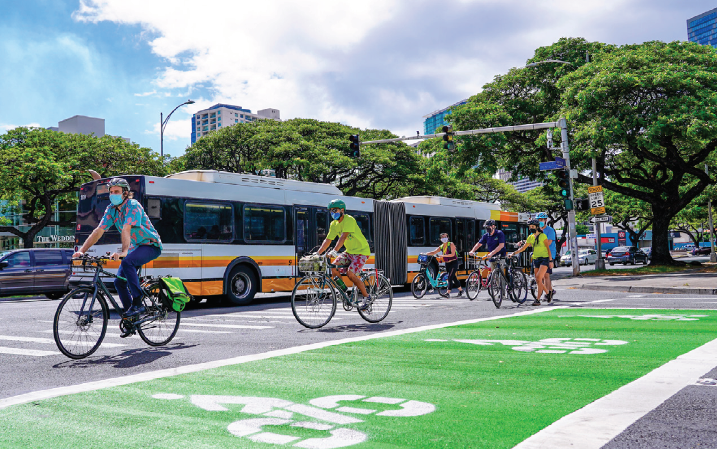Honolulu’s Mayor announced new green protected bike lanes and more electric buses as first steps toward the goals of the city’s first Climate Action Plan.
The NRDC Action Fund is driving climate action in cities across the country through the Bloomberg Philanthropies American Cities Climate Challenge.
Update 6/2/2021: Honolulu’s City Council unanimously adopted the city’s first-ever Climate Action Plan. Through ambitious strategies on transportation, buildings, energy, and more, the plan commits the city to cutting carbon emissions 45% by 2025. NRDC and local partners including the Hawai’i Youth Climate Coalition, Blue Planet Foundation, Faith Action for Community Equity, Ulupono Initiative, Blue Zones Project Hawai’i, and Sierra Club of Hawai’i urged both the plan’s passage and its rapid implementation. Key next steps include adoption of the city’s first Pedestrian Plan and a policy to benchmark energy use in buildings community-wide to help create jobs, save energy, and save money.
On Earth Day, Honolulu’s Mayor Rick Blangiardi and his Resilience Office released a final draft of the city’s very first Climate Action Plan. More than a year and many community meetings in the making, the plan spells out the actions required to cut emissions in Honolulu by 45 percent in the next five years.
If the plan is adopted and implemented, the city will deliver on its commitment to meet the goals of the Paris Climate Agreement and go below zero emissions by 2045. The plan must still be voted on by Honolulu’s City Council.
Contact your Councilmember to urge them to pass the Climate Action Plan — and implement it!
Emissions are increasing, especially from driving
As the Climate Action Plan looks forward, Honolulu’s Sustainability Report looks back. The city’s third annual report, also just released, tracks several sustainability indicators, including greenhouse gas emissions. These, unfortunately, have been increasing. The source of the biggest emissions increase was transportation: especially more people driving alone and driving more. Many Honolulu residents got electric cars, but that wasn’t enough to offset the impact of increased driving.
This emissions increase shows the need for action.
New options to reduce driving
At the Earth Day event, Mayor Blangiardi celebrated accomplishments, supported in part by the Bloomberg Philanthropies American Cities Climate Challenge, that will offer people more options besides driving:
- A new bright-green protected bike lane on Ward Street, offering a much safer ride along an important connection between the mountains and the water in the city’s downtown.
- Three new electric buses and plans for 14 more to arrive this year to provide cleaner, quieter rides on public transportation and improve air quality and reduce emissions as well.
These are a good start. The plan promises more to come, to accelerate cleaner, healthier transportation in Honolulu.

The plan was created with significant outreach and public input, in response to widespread concern about climate change.
Plan commitments
Honolulu’s Climate Action Plan outlines actions across nine strategies to reduce emissions from energy, ground transportation, and waste. These three sectors produce almost two-thirds of O‘ahu’s carbon emissions–and are the sectors that city government can influence.
Key priorities in the plan include:
- Building out more protected bike lanes
- Adopting the city’s first Pedestrian Plan and building safer walkways and crossings
- Creating more charging stations for electric vehicles
- Making all city-owned vehicles, including buses, all-electric by 2035
- Benchmarking city-owned buildings to track energy use and retrofitting them to increase energy efficiency, which can save an estimated $9 million in taxpayer dollars
- Benchmarking buildings community-wide to help building owners save energy and money.
Islands at risk
These actions, and more, are necessary to help protect Honolulu’s residents and their environment from the worst impacts of climate change.
Already, as the Climate Action Plan points out, average temperatures in Honolulu are hotter. Rain events and storms–and the landslides they trigger–are growing more severe. Cyclones and hurricanes are traveling more frequently toward Hawai‘i. The islands’ native plants, animals, and habitats, many found nowhere else, are at risk–especially the iconic coral reefs.
You can help
Contact your City Councilmember and encourage them to act to pass Honolulu’s first Climate Action Plan and call for its rapid implementation, for a safer, healthier future for all on O‘ahu.

